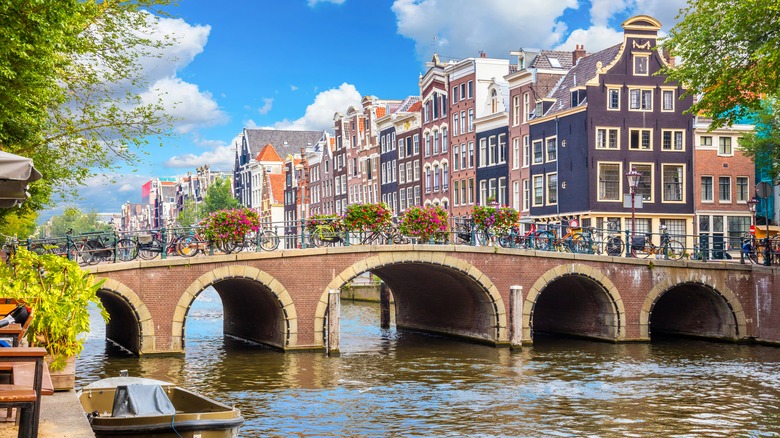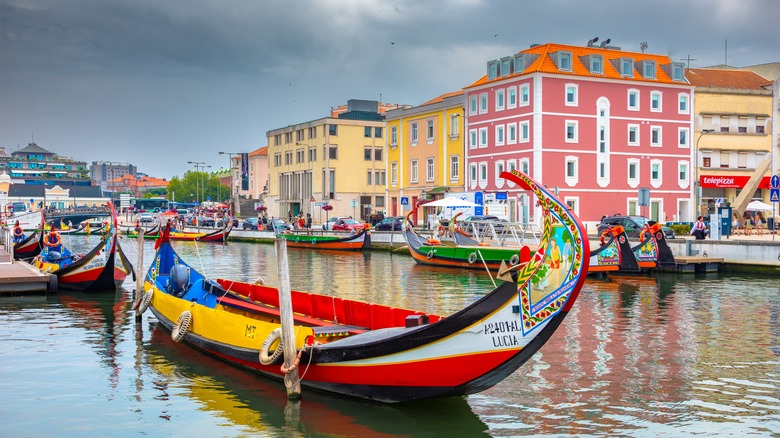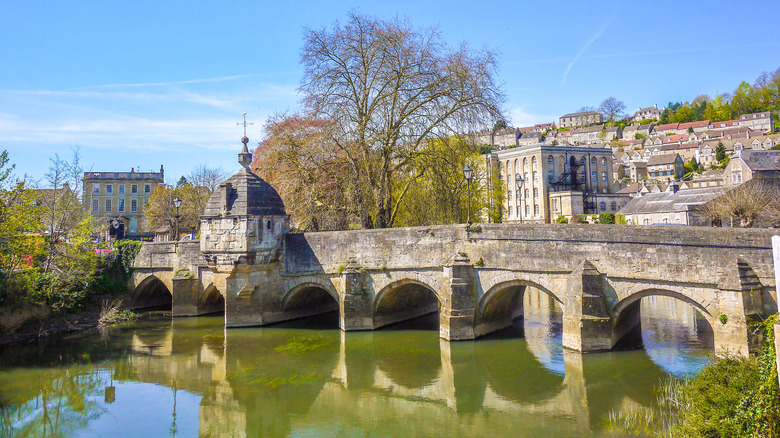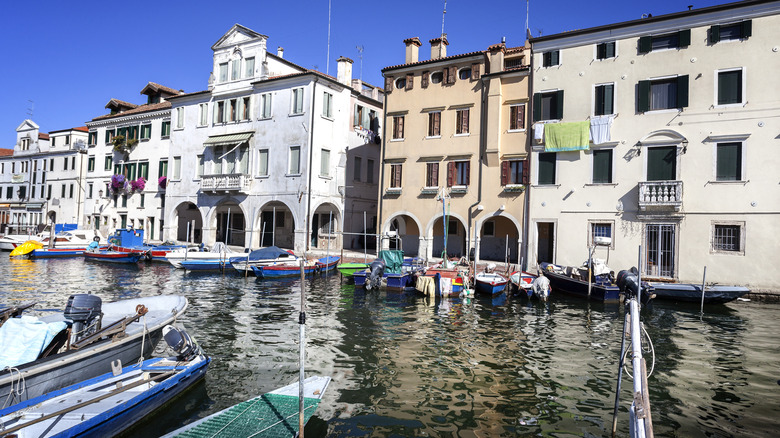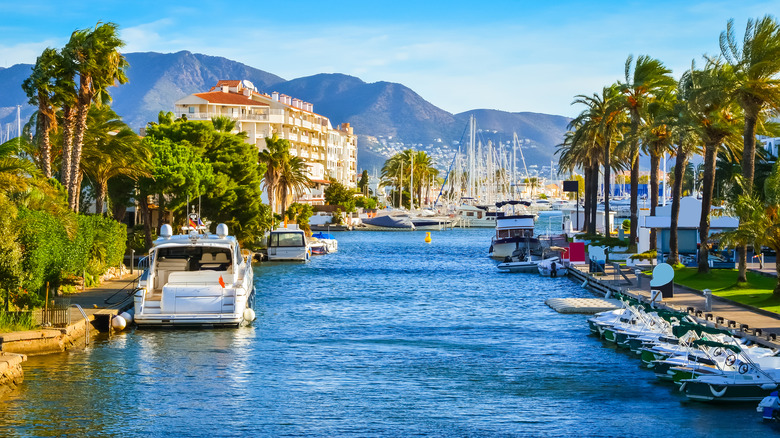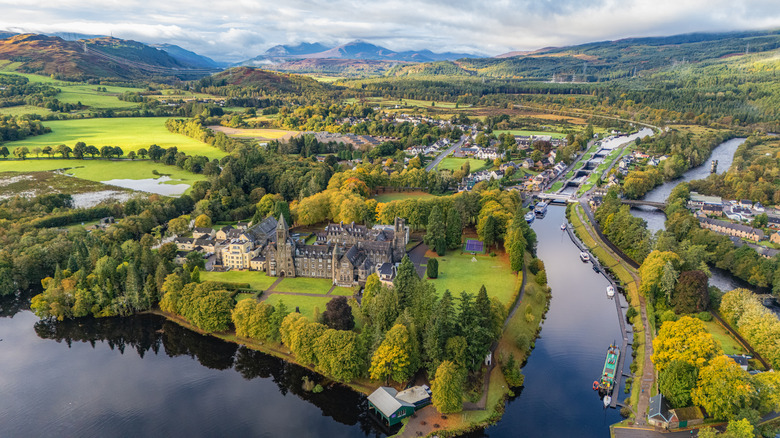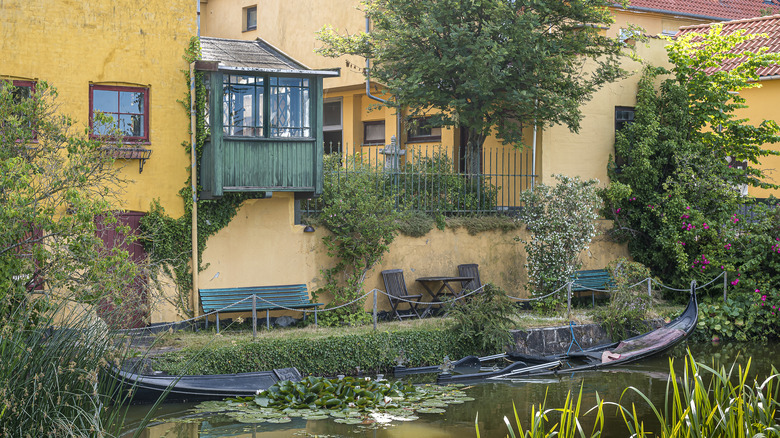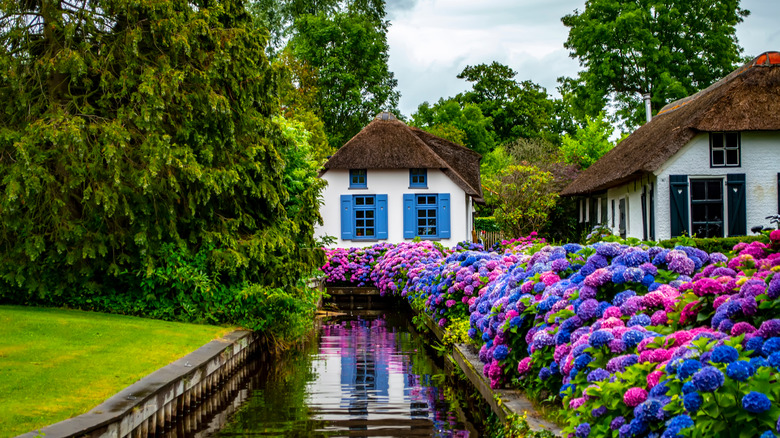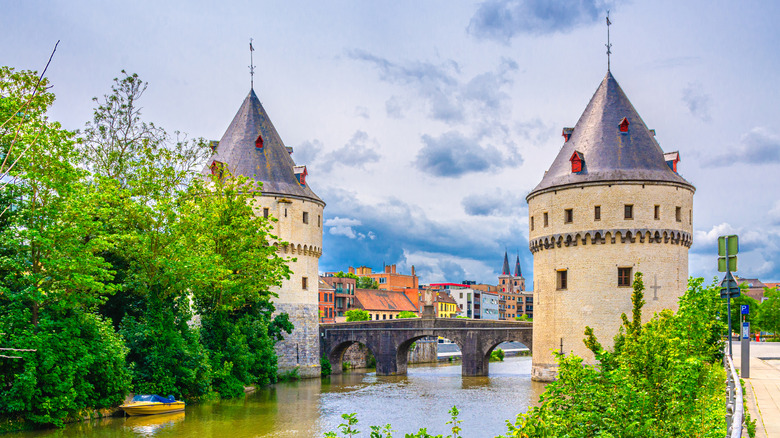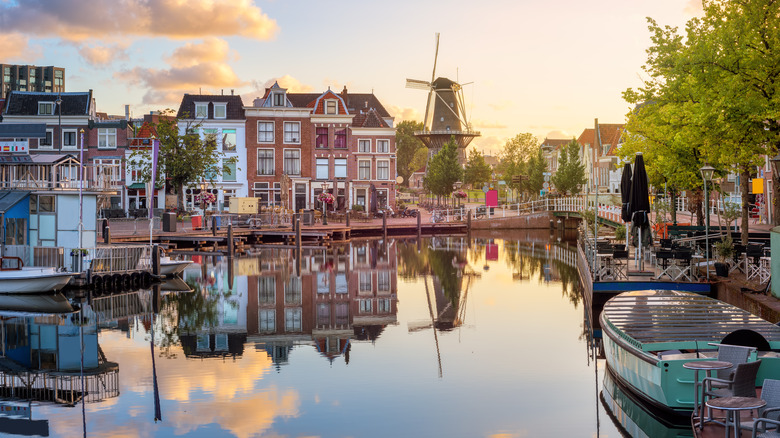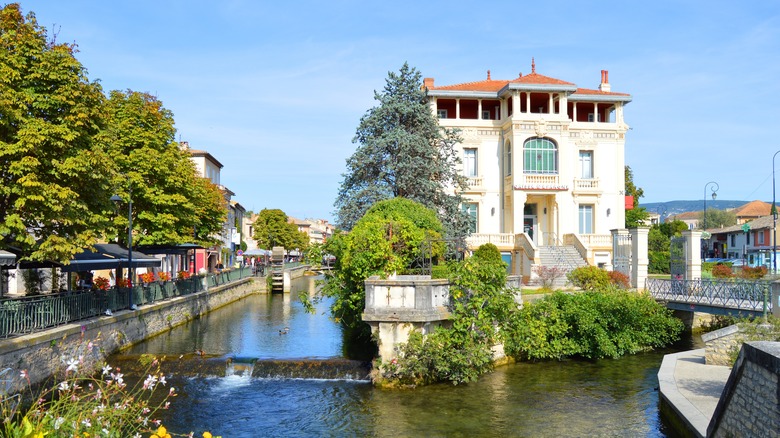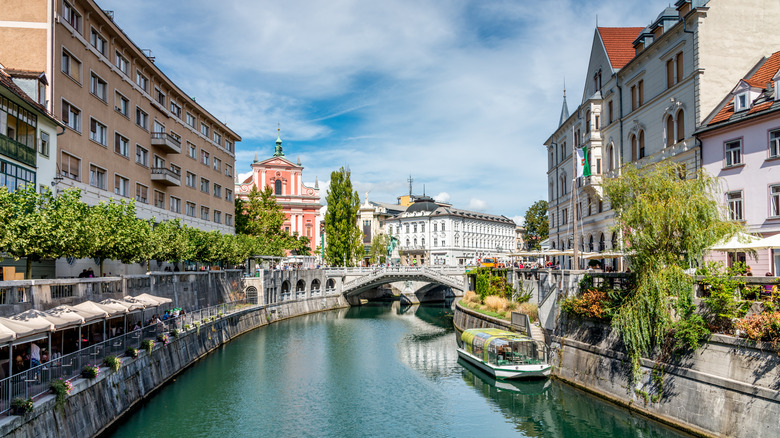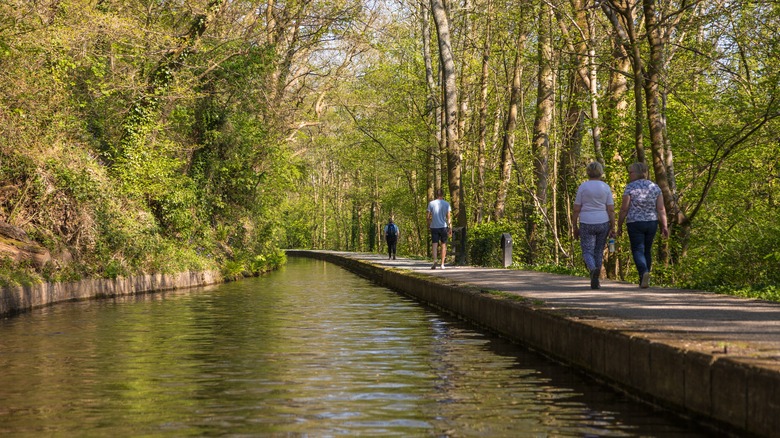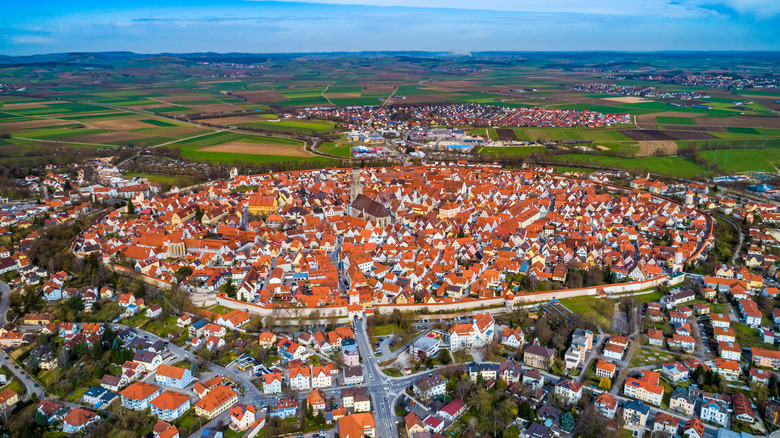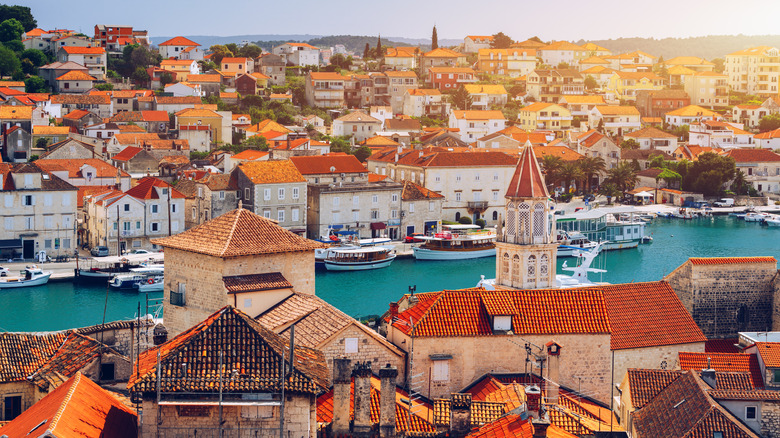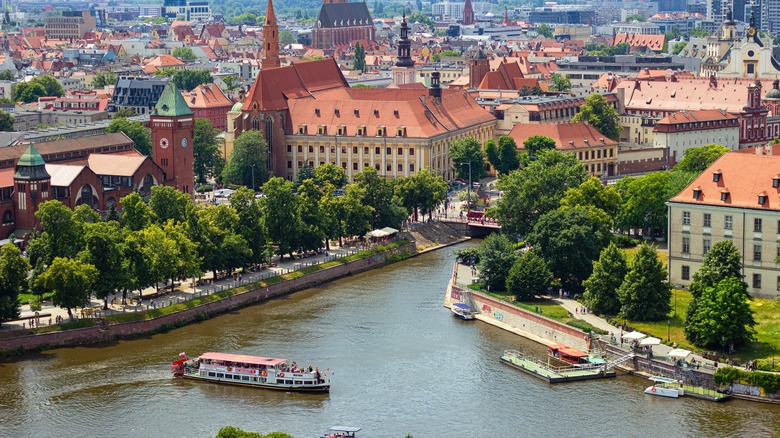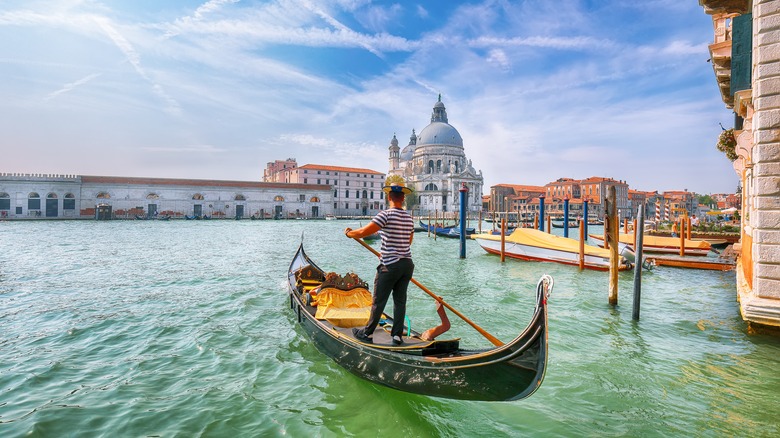European Towns With The Most Stunning Canals, According To Travel Bloggers
Canals have an irresistible allure. Perhaps the accompanying narrow channel of water gives them a sense of intimacy and personality. Or maybe it's the little, slow-moving vessels, some of which double up as homes, often spotted in these areas. It could be the way that canals tend to wind their way through a city, town, or village in an unassuming, almost hidden manner. Some sit on the outskirts of settlements flanked by greenery and tranquil walkways, while others cut through the heart of a location, acting as key thoroughfares.
In select places, the canals are as famous as the destinations themselves and need no introduction. In Europe, examples include Venice, Amsterdam, Bruges, Copenhagen, and Hamburg. But there are lesser-known gems in must-see European countries where canals remain an essential part of the urban fabric. We've scoured travel blogs and tourism board pages and put together a list of European towns where the canals are as picturesque as the places they inhabit.
Aveiro, Portugal
A town in the west of Portugal — a country that's an affordable honeymoon destination — Aveiro has plenty to offer beyond pretty canals, as highlighted by local traveler Catarina on her blog, A Portuguese Affair. Visitors will see beautiful boats on the waterfront and Art Nouveau buildings dotted around the area. The boats, called moliceiro, might make some visitors think of gondolas in Venice. Slender and long, with curved ends, they are unique to Aveiro and have become an iconic totem of the destination. They often have brightly decorated exteriors, lovingly painted with imagery denoting the owner's provenance or religious affiliation.
Once used by fishermen to gather moliço, a type of seagrass used as fertilizer, the boats' cargo today is more likely to be tourists. The canals that dissect Aveiro run past colorful homes or larger, sturdy Art Nouveau structures. Sometimes, they pass under bridges that carry motor traffic. Other bridges are smaller and more ornate, with high arches and intricate artistry designed to accommodate only pedestrians.
Bradford-on-Avon, England
A waterway that extends for more than 85 miles, the Kennet & Avon Canal links London, the British capital, with England's West country. Along its journey, it encounters 104 locks and passes some beloved English countryside, like the Cotswolds. One of the towns along the canal is Bradford-on-Avon, so named because it also sits on the River Avon. In the 1800s, Bradford-on-Avon was one of the busiest parts of the canal, with a teeming wharf that welcomed boats galore. It's a quieter, quintessential small English town today, but the boating scene remains lively.
Visitors can start by the wharf and watch boats rising and falling at the locks. Buildings nearby include the Old Lock Keeper's Cottage, while along the towpath, travelers will find a barn that dates to the 14th century. A short walk from the canal, Bradford-on-Avon reveals stone houses, pubs, and narrow shopping lanes flanked by Tudor architecture. Close to town, the Avoncliff Aqueduct is a marvel of engineering and a tourist attraction. A few hundred feet in length and about 60 feet wide, it allows the canal to cross over the River Avon from high up in the air.
Chioggia, Italy
As the crow flies, Chioggia isn't far from Venice, sitting a short distance to the south. The experience of the two, however, is markedly different, and in this town, visitors can enjoy canal life without the crowds or the tourism fee. The cityscape might remind travelers of Venice, with colorful buildings lining canals, boats tied to posts, and high-arched bridges affording pedestrians passage over the waters. Wander around Chioggia, and you'll find many churches, some with soaring clock towers.
Chioggia, which receives plenty of tourists, doesn't rely solely on visitors to keep its economy afloat, as detailed by Venice-based blogger Monica Cesarato. Fishing remains a key industry there (the bustling fish market is testimony to this), as does agriculture (pink radicchio is a local specialty). Tourism certainly helps, with boats taking travelers to nearby beaches while others roam around the town to admire the medieval architecture or the simple pleasure of waterfront living.
Empuriabrava, Spain
Northeast of Barcelona and not far from the border with France, Empuriabrava feels like a city of water. A giant marina with houses alongside the water makes up part of it. The town sits within a larger region called Castello d'Empúries-Empuriabrava, where attractions range from sizeable beaches and parks to medieval hamlets and Gothic churches.
In Empuriabrava, visitors will find many miles of water to navigate, a far cry from what was there 60 years ago. Back then, the coast was swampy, but it has transformed into one of the continent's biggest residential marina complexes through meticulous development. Empuriabrava is the kind of place where a resident will leave home, slide into their boat, and maybe navigate over to a friend's place along the canal network. The marina area forms the bulk of the town, though travelers can find beaches elsewhere and even, perhaps surprisingly, an indoor skydiving facility.
Fort Augustus, Scotland
Whether or not you believe in mythical creatures, chances are you've heard of Loch Ness. A lake in Scotland, it's where Nessie, the Loch Ness monster, lives, and it's also right by Fort Augustus. The village is small but has grand scenery, from the long, slender expanse of the lake to the craggy hills that rise from the water's edge. The lake feeds into the River Oich and the Caledonian Canal at Fort Augustus, making the settlement a boater's delight.
A series of locks unfurls along the canal, and by the side, travelers will find towpaths, as well as quaint homes tucked between lawns and trees. The village is the setting of Fort Augustus Abbey, a former fort and monastery from the 1800s now home to accommodations and landscaped grounds. Views take in the lake, 20 acres of land, and the canal that runs alongside the property, a classic Scottish estate now known as The Highland Club.
Frederiksværk, Denmark
The Danish capital of Copenhagen will be familiar to fans of canal towns, especially the area of Nyhavn, with its bright buildings featuring gabled roofs. But this town north of the capital is also an attractive destination for travelers who yearn to admire colorful houses. Alongside the canals of Frederiksværk, vibrant yellow homes inject energy into the urban fabric. Visitors can amble by the canals, cross the water on one of the high-arched bridges, and stop for a drink or bite in a cafe.
The canals were a vital part of the industrial town's existence. They were built in the 18th century to power the gunpowder mills, which were an important local industry — they made bullets for the Danish royals for centuries. Visitors can experience this history with a trip to Krudstværksmuseet (or Gunpowder Works Museum). Tours of the canals and Lake Arresø (the largest lake in Denmark) offer a window onto the region's maritime history.
Giethoorn, Netherlands
For a slice of pastoral, idyllic bliss, this village with thatch roofs and colorful canal-side blooms is a perfect choice. Giethoorn is a small hamlet with only a few thousand residents, but what it lacks in size, it makes up for in sheer, undeniable charm. The canals were excavated by hand, while some homes date to the 1700s. Greenery on either side of the canals, which are very narrow in sections, adds to the allure of the destination. As does the vast number of bridges, more than 150 of them.
The postcard-worthy setting has not been lost on tourists who come in droves to experience this slice of rural splendor and visit a village that might bring to mind Hobbiton from "Lord of the Rings." In addition to the waterways where travelers can rent boats or join a canal tour, there are walking and cycling paths (per the blog Hello Graciemo). However, visitors won't find many roads, as the village is car-free.
Kortrijk, Belgium
In the west of Belgium, part of a region called Flanders, Kortrijk sits along a couple of waterways — the Leie-Scheldt Canal and the Leie River. The city can trace its origins to an old Roman settlement, followed sometime later by the opening of a chapel in the 7th century. The Middle Ages is when Kortrijk was, in its heyday, a powerhouse in the production of linen. Occupation since then by the French and Germans and large-scale destruction during World War II have taken a toll on Kortrijk.
Hallmarks of Kortrijk's medieval structures are very much evident, and Gothic buildings are visible across the cityscape, tucked alongside the modern edifices. Among the most well-known sights are the Gothic town hall, St. Martin's Church, and the Broelbrug, a bridge bookended by two sturdy towers. Kortrijk's glory days of textile production are also making a comeback, with the city once again a player in the European linen trade.
Leiden, Netherlands
While Giethoorn introduces visitors to the intimate composition of a canal destination, Leiden has more in common with the country's other great canal cynosure — Amsterdam. Southwest of the Dutch capital, Leiden features miles and miles of serene canals that pass rows of homes on tree-lined streets. While Leiden might not have the population of Amsterdam — 130,000 vs 900,000 — the waterways there are certainly far-reaching, spanned by 88 bridges in all.
"Singels," or moats, wrap around the center of the city, and waterfronts boast cafes, restaurants, parks, and houses. Boat hires are a popular way to explore Leiden, or travelers can easily join a tour with operators like Rondvaart Leiden. Some tours feature food onboard, ranging from pizza to barbecue to fries. A guide dressed as the Dutch master Rembrandt van Rijn leads another excursion. History buffs might want to stop at the Rijksmuseum Van Oudheden, an antiquities museum that showcases works from ancient Egypt, Rome, and more.
L'Isle-sur-la-Sorgue, France
Canals, cafes, and antiques are hallmarks of this town in Provence, located southeast of Avignon. It's a wildly charming destination; flowers enliven bridges, and water wheels along the canals and river attest to the town's industrial past. L'Isle-sur-la-Sorgue was once the realm of fabric dyers and silk spinning facilities, as well as a hub for fishing.
Commerce still courses through its DNA, with antique vendors ubiquitous. Visitors will find them everywhere, from dockside by the canals to spots like year-round flea markets in the Village des Antiquaires. This is one of the biggest antique venues in Europe, and hundreds of dealers hawk their aged wares there (some estimates put the number of dealers at 300 in a town of about 20,000 residents).
Antiques aren't L'Isle-sur-la-Sorgue's only lure, with Provençal markets and shops easy to find. One annual highlight is the Nego Chin, a market on August 1 that makes the most of the town's canal setting. Vendors in white shirts, waistcoats, and hats sing as they sell their provisions from richly decorated boats.
Ljubljana, Slovenia
For residents of the capital of Slovenia, a day trip to Venice is a very realistic proposition — the Italian canal fantasyland is only a few hours from Ljubljana. Yet, the Slovenian city has charming canals of its own. The Ljubljana River Canal winds its way through the settlement, deep into its historic core. History pours from the centuries-old buildings on one side of the canal, while the other side presents the newer part of the city. Solid embankments climb from segments of the canal, rising to reveal waterside cafes and restaurants.
Sipping a coffee at a canal-side boîte is a fine way to enjoy the setting. Pathways allow visitors to leisurely stroll by the waterfront and soak in the city's rhythm. You'll also be able to appreciate the architecture, a rich vein of variety, from Brutalism to Baroque to Art Nouveau, as well as the multitude of green spaces.
Llangollen, Wales
This town in rural Wales, a country with many reasons to visit, also lends its name to the Llangollen Canal. The waterway cuts through the border of England and Wales along its 41-mile meander. The canal has some fine countryside scenery, pretty market towns, lakes, valleys, and historic structures. Among them is Pontcysyllte Aqueduct, a Unesco World Heritage site. Extending more than 1,000 feet, it showcases the ground-breaking engineering of the late 18th century, with masonry and metal combining to create a waterway 38 meters (about 125 feet) above the River Dee.
Visitors can sample the area's pastoral beauty with a trip from Llangollen Wharf. Options include a self-drive boat hire excursion and guided tours on a boat atop the aqueduct. The most serene choice is to board a vessel pulled by a horse on the towpath. The town itself is a relaxing destination, with a wide range of independent shops, a picnic-primed green space in Riverside Park, and a variety of accommodation alternatives.
Nördlingen, Germany
From above, the layout of this town in Bavaria is quite special, according to the blog Susan Finlay Writes. The circular form reflects the wall that runs around the settlement, and with a walkway on top, circumambulating Nördlingen from above is not hard to do. More than 1,000 years old, the town has red peaked roofs atop timber homes and curling streets that seem to have stood still for centuries. Many of them are made of cobblestones, adding a sense of history to Nördlingen. Walking the town, visitors might spy the canals dotted around the area, compact stretches of water that run right up alongside homes.
Even more interesting, perhaps, is that Nördlingen sits within the depression of a giant crater. The Ries crater, as it's known, is more than 15 miles wide, created when an asteroid slammed into this part of the planet. Visitors can learn more about this astrological and geological phenomenon at the town's RiesKraterMuseum, housed in a barn dating back to the early 1500s. It's a good spot for a museum visit in Europe.
Trogir, Croatia
A Unesco World Heritage site, Trogir has a historic core on an island separated from the mainland by a broad, precise canal. Croatia is an excellent country for island hopping, and this destination, which sits a short drive from Split, is no exception. The island is connected to the main chunk of Trogir by a bridge to the north, while on the south, a separate bridge links the historic center to the island of Ciovo and its wealth of beaches. Comprising stone buildings with red-tile roofs and Venetian architecture, it's little wonder that Trogir has been compared to Italy's most famous canal destination. Parts of the town feel as though they still belong in the Middle Ages, featuring tight, curling alleys with cobblestone streets and aged houses.
Trogir is a great place just to wander and believe you've stepped back in time. A number of sites stand out. The Cathedral of St. Lovro dates back to the 1200s and features works by one of Croatia's most renowned sculptors, Radovan. From the cathedral bell tower, views of the historic center and mainland mountains seem to go on forever. Kamerlengo Fortress is a mighty structure built by the Venetians as a naval base; today, it acts as a cultural event hub. For a relaxing summer evening stroll, visitors often amble along the promenade, or "riva."
Wroclaw, Poland
In this Polish city in the country's southwest, water is everywhere. That's because it's a city of islands and waterways that wind around them. Some are tributaries and rivers, like the Śleza, Odra, and Bystrzyca, but there are also canals and a moat. This has earned Wroclaw the nickname the Venice of Poland, or Venice of the North, and it's a destination with more than 100 bridges. One of those spans, Most Grunwaldzki, is the longest suspension bridge in the country, while others are far more intimate.
The link to water is so important there that Wroclaw is home to Hydropolis. A museum of sorts, it's housed in a former water reservoir, with exhibits ranging from the riches of the Mariana Trench to a snow-making machine. Outdoor enthusiasts who take to boats, cruises, and kayaks also enjoy the waterways, as well as patrons of the many beach bars by the rivers and canals.
Methodology
Travelers can encounter canals all over Europe and the world. Some have entered public consciousness or lore by dint of their size and setting. Think of shipping arteries like the Panama Canal or cities like Amsterdam, Venice, Bangkok, and Suzhou (in China). To winnow down a list of towns in Europe with stunning canals, we consulted a variety of sources. Blogs and operators served as a starting point, especially those that spotlight boating, like Love Travelling Blog, Le Boat, and Drifters. We also consulted travel blogs like Becky In Portugal, Wandering Italy, and Oliver's Travels, rounding out the content with information from tourism boards and official canal bodies. We further strived to steer away from the obvious choices and present lesser-known jewels across the continent.
